

37 Water Science Experiments: Fun & Easy
We’ve curated a diverse selection of water related science experiments suitable for all ages, covering topics such as density, surface tension, water purification, and much more.
These hands-on, educational activities will not only deepen your understanding of water’s remarkable properties but also ignite a passion for scientific inquiry.
So, grab your lab coat and let’s dive into the fascinating world of water-based science experiments!
Water Science Experiments
1. walking water science experiment.
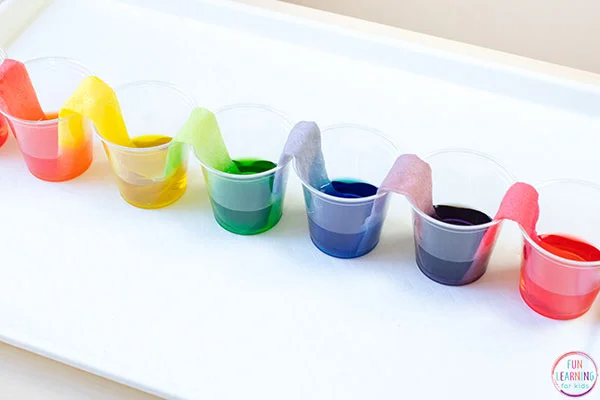
This experiment is a simple yet fascinating science experiment that involves observing the capillary action of water. Children can learn a lot from this experiment about the characteristics of water and the capillary action phenomenon. It is also a great approach to promote scientific curiosity and enthusiasm.
Learn more: Walking Water Science Experiment
2. Water Filtration Experiment
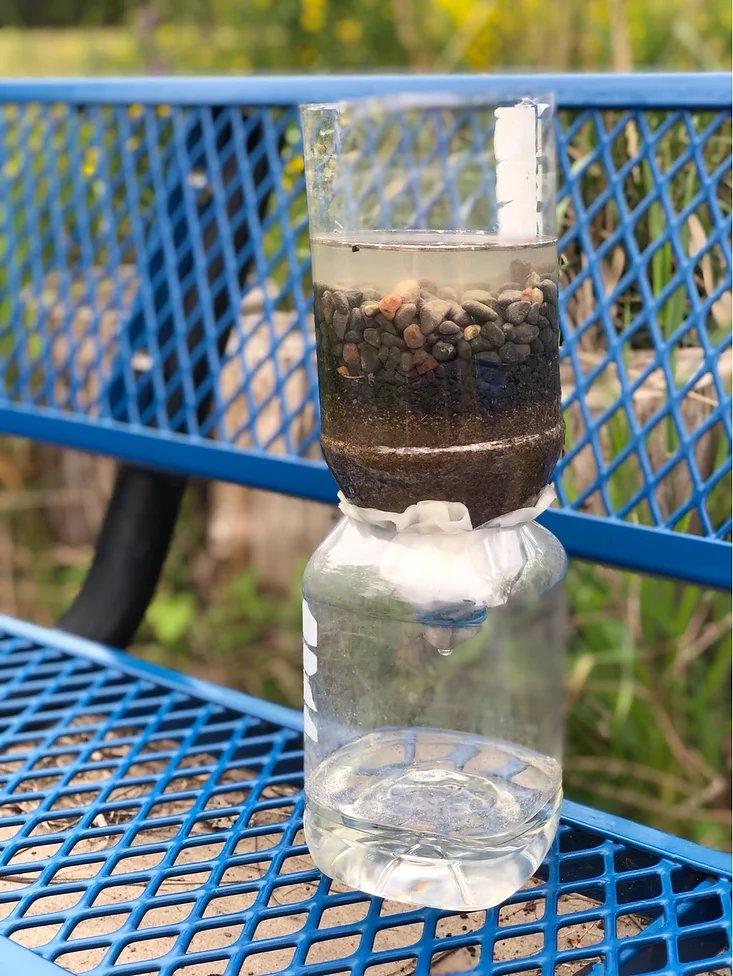
A water filtering experiment explains how to purify contaminated water using economical supplies. The experiment’s goal is to educate people about the procedure of water filtration, which is crucial in clearing water of impurities and contaminants so that it is safe to drink.
Learn more: Water Filtration Experiment
3. Water Cycle in a Bag
The water cycle in a bag experiment became to be an enjoyable and useful instructional exercise that helps students understand this idea. Participants in the experiment can observe the many water cycle processes by building a model of the water cycle within a Ziplock bag.
4. Cloud in a Jar
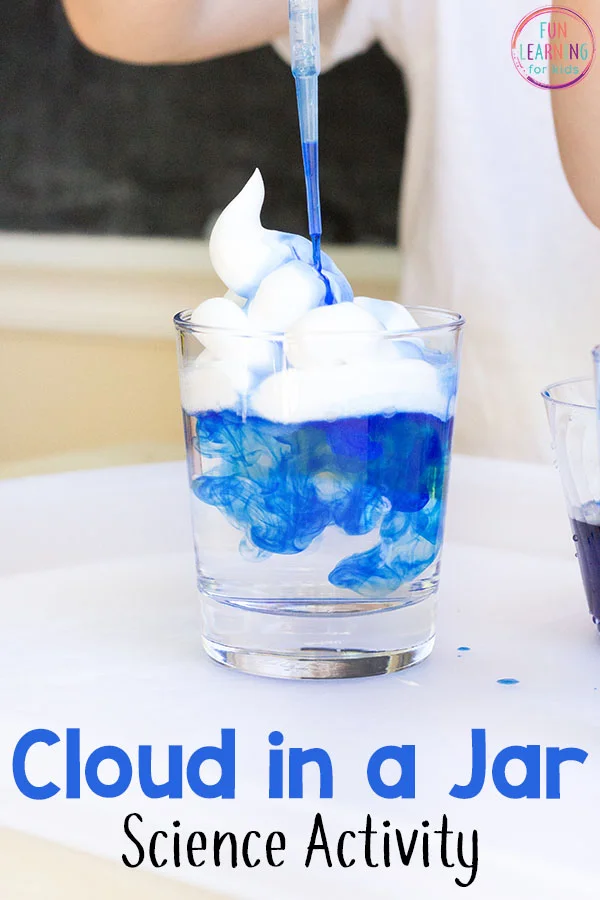
The rain cloud in a jar experiment is a popular instructional project that explains the water cycle and precipitation creation. This experiment is best done as a water experiment since it includes monitoring and understanding how water changes state from a gas (water vapor) to a liquid (rain) and back to a gas.
Learn more: Cloud in a Jar
5. The Rising Water
The rising water using a candle experiment is a wonderful way to teach both adults and children the fundamentals of physics while also giving them an exciting look at the properties of gases and how they interact with liquids.
6. Leak Proof Bag Science Experiment
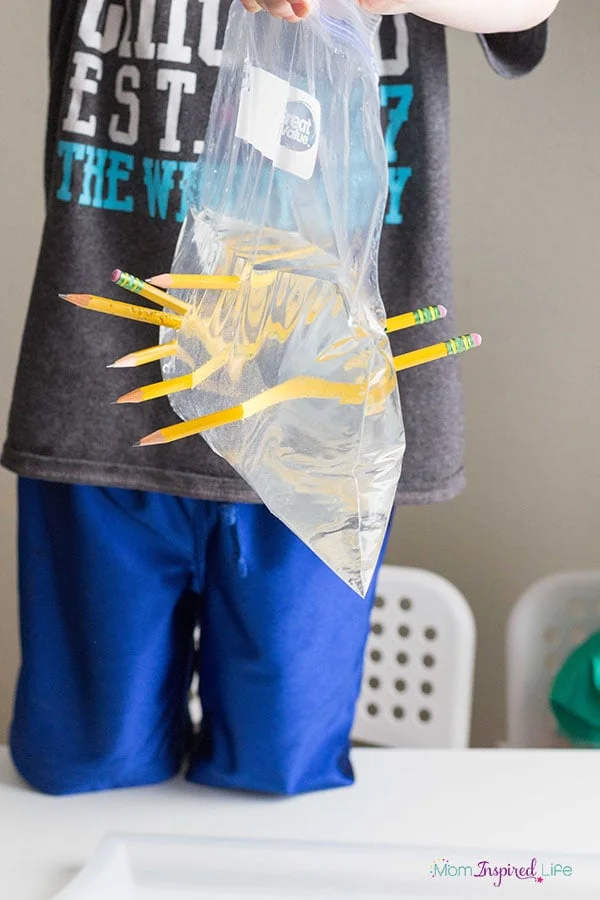
In the experiment, a plastic bag will be filled with water, and after that, pencils will be inserted through the bag without causing it to leak.
The experiments explain how the plastic bag’s polymer chains stretch and form a barrier that keeps water from dripping through the holes the pencils have produced.
Learn more: Leak Proof Bag Science Experiment
7. Keep Paper Dry Under Water Science Experiment
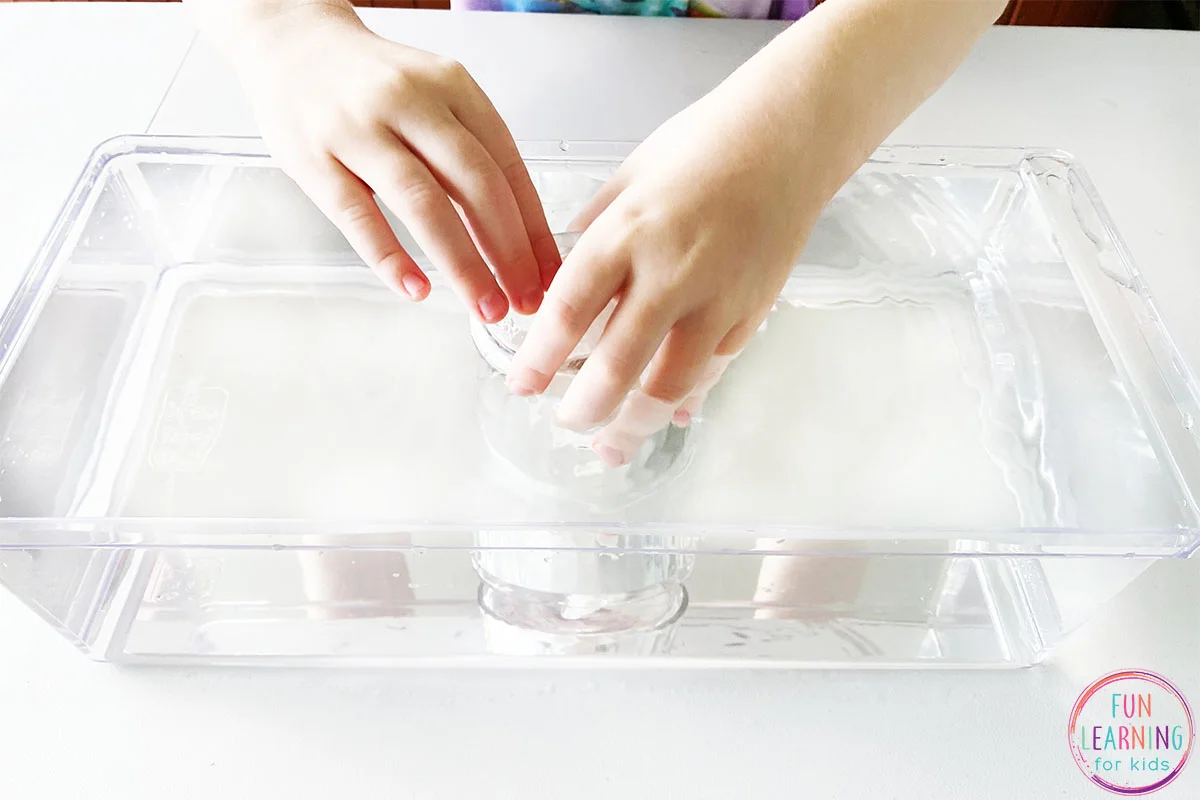
The experiment is an enjoyable way for demonstrating air pressure and surface tension for both adults and children. It’s an entertaining and engaging technique to increase scientific curiosity and learn about scientific fundamentals.
Learn more: Keep Paper Dry Under Water Science Experiment
8. Frozen Water Science Experiment
The Frozen Water Science Experiment is a fun and engaging project that teaches about the qualities of water and how it behaves when frozen.
You can gain a better knowledge of the science behind the freezing process and investigate how different variables can affect the outcome by carrying out this experiment.
9. Make Ice Stalagmites
10. Bending of Light
A fascinating scientific activity that explores visual principles and how light behaves in different surfaces is the “bending of light” water experiment. This experiment has applications in physics, engineering, and technology in addition to being a fun and interesting method to learn about the characteristics of light.
11. Salt on a Stick
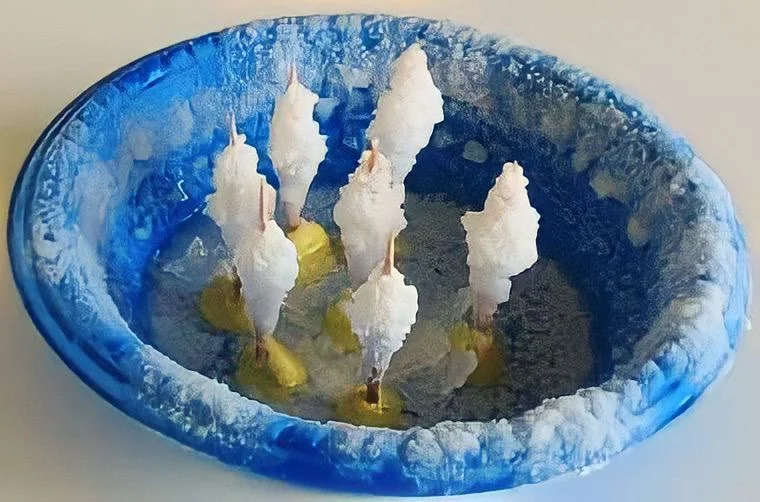
This experiment is an excellent way to catch interest, engage in practical learning, and gain a deeper understanding of the characteristics of water and how they relate to other substances. So the “Salt on Stick” water experiment is definitely worth trying if you’re looking for a fun and educational activity to try!
Learn More: Water Cycle Experiment Salt and Stick
12. Separating Mixture by Evaporation
This method has practical applications in fields like water processing and is employed in a wide range of scientific disciplines, from chemistry to environmental science.
You will better understand the principles determining the behavior of mixtures and the scientific procedures used to separate them by performing this experiment at home.
13. Dancing Spaghetti
Have you ever heard of the dancing spaghetti experiment? It’s a fascinating science experiment that combines simple materials to create a mesmerizing visual display.
The dancing spaghetti experiment is not only entertaining, but it also helps you understand the scientific concepts of chemical reactions, gas production, and acidity levels.
14. Magic Color Changing Potion
The magic color-changing potion experiment with water, vinegar, and baking soda must be tried since it’s an easy home-based scientific experiment that’s entertaining and educational.
This experiment is an excellent way to teach kids about chemical reactions and the characteristics of acids and bases while providing them an interesting and satisfying activity.
15. Traveling Water Experiment
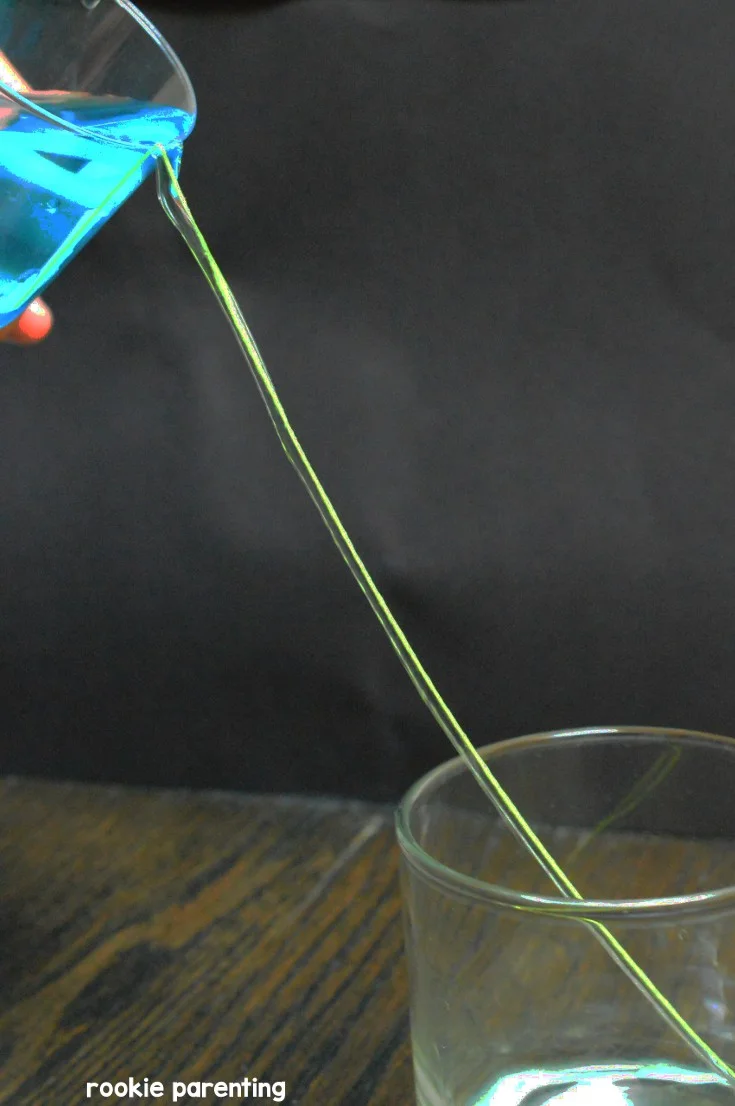
In this experiment, you will use simple objects like straws or strings to make a path for water to pass between two or more containers.
Learn more: Rookie Parenting
16. Dry Erase and Water “Floating Ink” Experiment
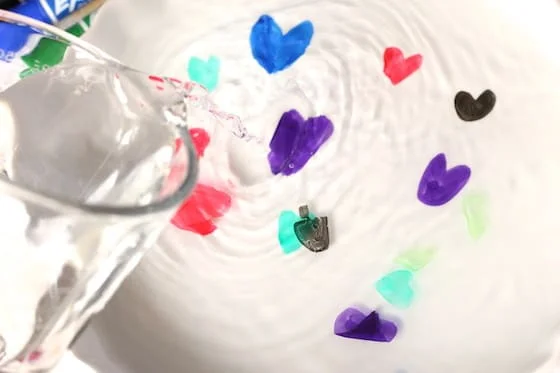
The dry-erase and water “floating ink” experiment offers an interesting look at the characteristics of liquids and the laws of buoyancy while also being a great method to educate kids and adults to the fundamentals of science.
Learn more: Dry Erase and Water Floating Ink Experiment
17. Underwater Candle
In this experiment, we will investigate a connection between fire and water and learn about the remarkable factors of an underwater candle.
18. Static Electricity and Water
19. Tornado in a Glass
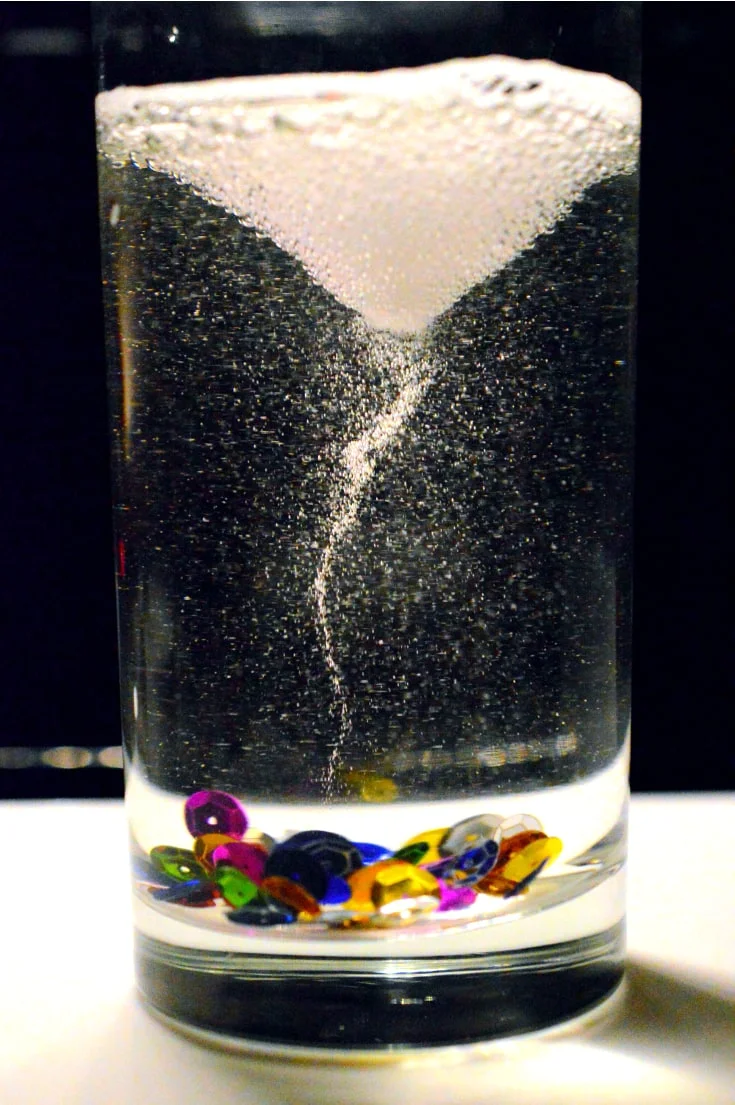
This captivating experiment will demonstrate how the forces of air and water can combine to create a miniature vortex, resembling a tornado.
Learn more: Tornado in a Glass
20. Make Underwater Magic Sand
Be ready to build a captivating underwater world with the magic sand experiment. This experiment will examine the fascinating characteristics of hydrophobic sand, sometimes referred to as magic sand.
21. Candy Science Experiment
Get ready to taste the rainbow and learn about the science behind it with the Skittles and water experiment! In this fun and colorful experiment, we will explore the concept of solubility and observe how it affects the diffusion of color.
Density Experiments
Density experiments are a useful and instructive approach to learn about the characteristics of matter and the fundamentals of science, and they can serve as a starting point for further exploration into the fascinating world of science.
Density experiments may be carried out with simple materials that can be found in most homes.
This experiment can be a great hands-on learning experience for kids and science lovers of all ages.
22. Super Cool Lava Lamp Experiment
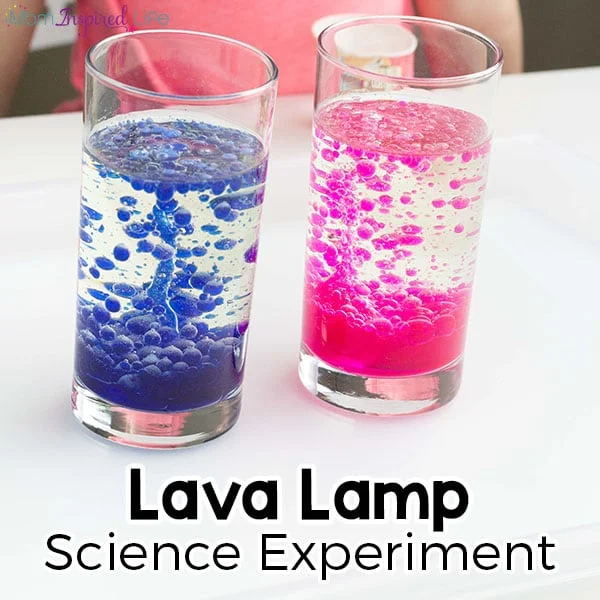
The awesome lava lamp experiment is an entertaining and educational activity that illustrates the concepts of density and chemical reactions. With the help of common household items, this experiment involves making a handmade lava lamp.
Learn more: Lava Lamp Science Experiment
23. Denser Than you Think
Welcome to the fascinating world of density science! The amount of matter in a particular space or volume is known as density, and it is a fundamental concept in science that can be seen everywhere around us.
Understanding density can help us figure out why some objects float while others sink in water, or why certain compounds do not mix.
24. Egg Salt and Water
Learn about the characteristics of water, including its density and buoyancy, and how the addition of salt affects these characteristics through performing this experiment.
25. Hot Water and Cold-Water Density
In this experiment, hot and cold water are put into a container to see how they react to one other’s temperatures and how they interact.
Sound and Water Experiments
Have you ever wondered how sound travels through different mediums? Take a look at these interesting sound and water experiments and learn how sounds and water can affect each other.
26. Home Made Water Xylophone
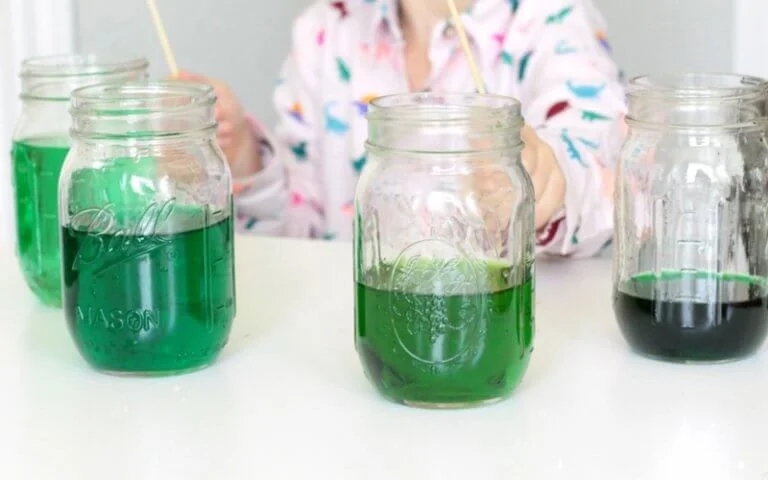
You can do this simple scientific experiment at home using a few inexpensive ingredients to create a handmade water xylophone.
The experiment demonstrates the science of sound and vibration and demonstrates how changing water concentrations can result in a range of tones and pitches.
Learn more: Home Made Water Xylophone
27. Create Water Forms Using Sound!
A remarkable experiment that exhibits the ability of sound waves to influence and impact the physical world around us is the creation of water formations using sound.
In this experiment, sound waves are used to generate patterns and shapes, resulting in amazing, intricate designs that are fascinating to observe.
28. Sound Makes Water Come Alive
These experiments consist of using sound waves to create water vibrations, which can result in a variety of dynamic and captivating phenomena.
29. Water Whistle
The water whistle experiment includes blowing air through a straw that is submerged in water to produce a whistle.
This experiment is an excellent way to learn about the characteristics of sound waves and how water can affect them.
Water Surface Tension Experiments
You can observe the effects of surface tension on the behavior of liquids by conducting a surface tension experiment.
By trying these experiments, you can gain a better understanding of the properties of liquids and their behavior and how surface tension affects their behavior.
30. Floating Paperclip
In this experiment, you will put a paper clip on the top of the water and observe it float because of the water’s surface tension.
31. Water Glass Surface Tension
Have you ever noticed how, on some surfaces, water drops may form perfect spheres? The surface tension, which is a characteristic of water and the cohesive force that holds a liquid’s molecules together at its surface, is to blame for this.
32. Camphor Powered Boat
The camphor-powered boat experiment is a fun and fascinating way to explore the principles of chemistry, physics, and fluid mechanics. In this experiment, a miniature boat is used to travel across the water’s surface using camphor tablets.
33. Pepper and Soap Experiment
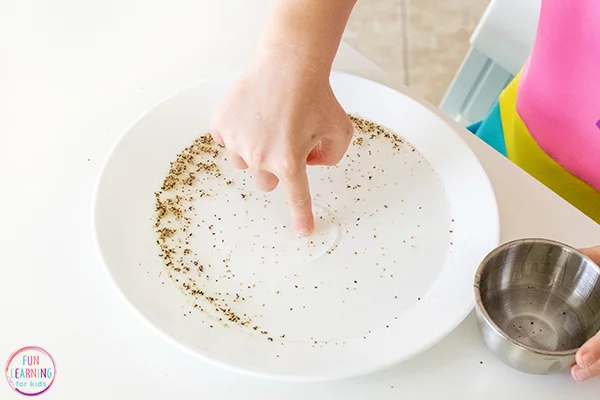
The pepper in a cloud experiment is a simple and interesting activity that explains the concept of surface tension. This experiment includes adding pepper to a bowl of water and then pouring soap to the mixture, causing the pepper to move away from the soap.
Learn more: Pepper and Soap Experiment
Boiling Water Experiments
Experiments with boiling water are an engaging and informative way to learn about physics, chemistry, and water’s characteristics.
These investigations, which include examining how water behaves when it changes temperature and pressure, can shed light on a variety of scientific phenomena.
It’s important to take the proper safety measures when performing experiments with hot water. Boiling water can produce steam and hot particles that are dangerous to inhale in and can result in severe burns if it comes into contact with skin.
34. Make It Rain
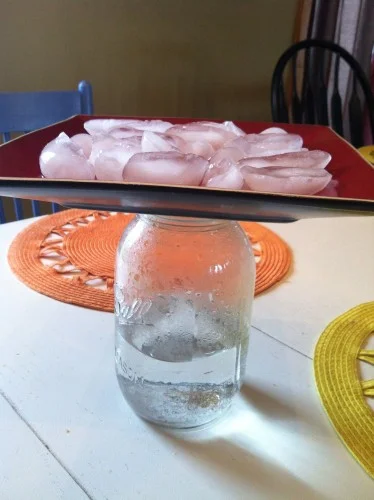
This experiment can be accomplished using basic supplies that can be found in most homes, make it an excellent opportunity for hands-on learning for both kids and science lovers.
Learn more: Make it Rain
35. Fire Water Balloons
Learning about the fundamentals of thermodynamics, the behavior of gases, and the effects of heat on objects are all made possible by this experiment.
36. Boil Water with Ice
The Boiling Water with Ice experiment is an engaging and beneficial approach to learn about temperature and the behavior of water. It can also serve as an introduction for further discovery into the wonderful world of science.

37. Boil Water in a Paper Cup
The “boil water in a cup” experiment is an easier but powerful approach to illustrate the idea of heat transmission by conduction. This experiment is often used in science classes to teach students about thermal conductivity and the physics of heat transfer.
Similar Posts:
- 68 Best Chemistry Experiments: Learn About Chemical Reactions
- Top 100 Fine Motor Skills Activities for Toddlers and Preschoolers
- Top 50 Fun Food Science Experiments
Leave a Comment Cancel reply
Save my name and email in this browser for the next time I comment.

Rainbow Walking Water Science Experiment for Kids
This walking water science experiment is so much fun and super easy to do! My kids absolutely loved it! It even comes with free printable recording sheets for kids as young as preschool! Check out the video to see how easy this walking water experiment really is. This rainbow activity is perfect for spring science!
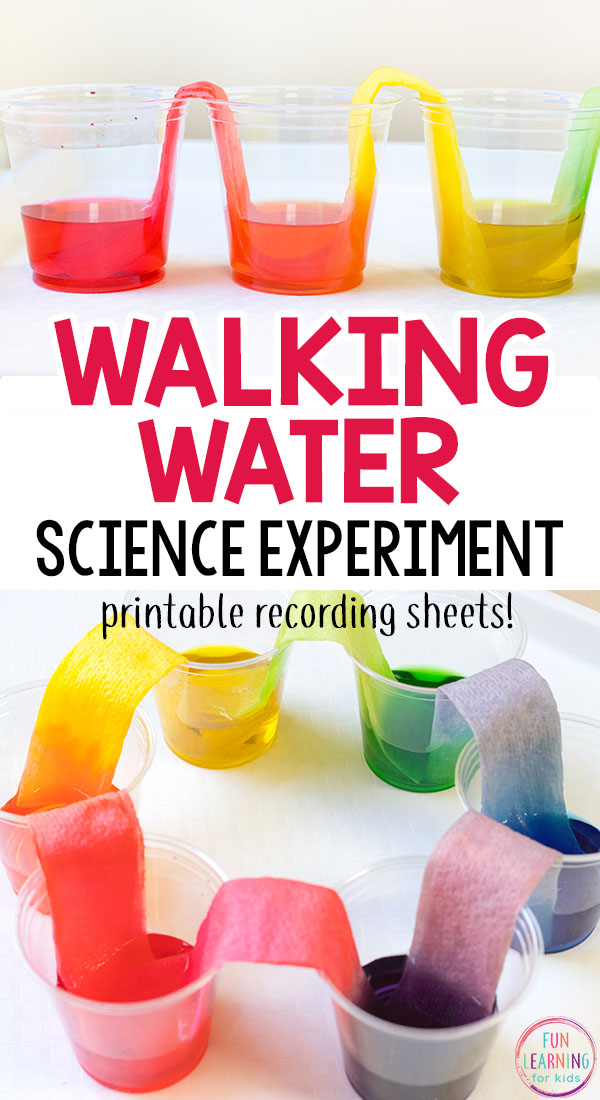
Walking Water Science Experiment
Ok, this might just be our favorite science experiment! The whole family (adults included) were completely mesmerized with process. We all couldn’t believe how quickly the water traveled up the paper towel and neat it was to watch the colors mix together.
We have wanted to try it out for a long time now and I am kicking myself for waiting so long. I don’t know why, but I thought it might be difficult to do or take a long time. I was way wrong. It was very easy and we started seeing results right away!
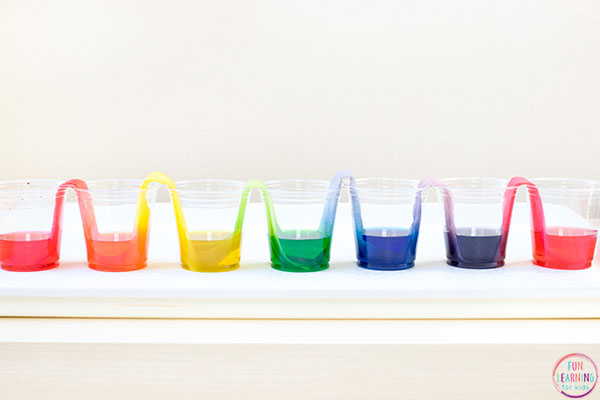
Related: Simple Spring Science and STEAM Activities
The walking water science experiment is great at any time of the year, but it is especially perfect for spring. I love doing rainbow activities in the spring, so this was a great addition to our rainbow theme activities.
If you are looking for simple science to do with the kids and something that will really WOW them, this is definitely one to try.
You only need a few simple supplies that you probably already have around the house.
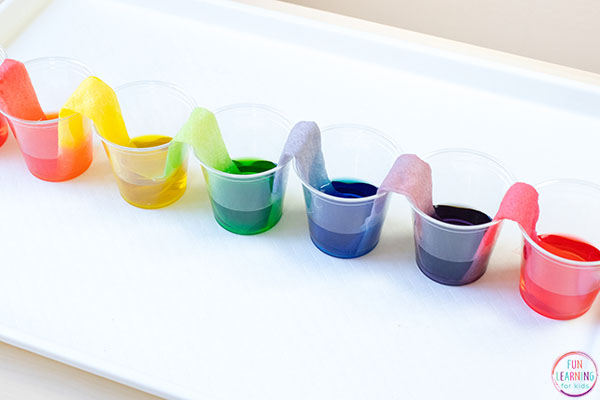
Setting Up the Rainbow Science Experiment
Supplies Needed:
- Printable walking water recording sheets (button to download at the bottom of the post)
- Small plastic cups or glasses
- Paper towels (*read my tips below for picking the right ones)
- Food coloring in primary colors
* The pick-a-size paper towels are best because then you just use half sheets for each cup. If you only have full sheets, then cut them in half. I’ve also heard that more absorbent paper towels work better too. I buy the cheap store brand ones, and our water moved pretty quickly from cup to cup, so I am not sure how important that is. It may have went quicker with something more absorbent though.
1. Print out the recording sheets and make copies, if needed.
2. Place 7 cups in a row and pour water in the 1st, 3rd, 5th, and 7th cup. My cups were about 3/4 full. I have since heard that fuller is better.
3. Add 5 drops of red food coloring to the 1st cup and the 7th cup.
4. Add 5 drops of yellow food coloring to the 3rd cup.
5. Add 5 drops of blue food coloring to the 5th cup.
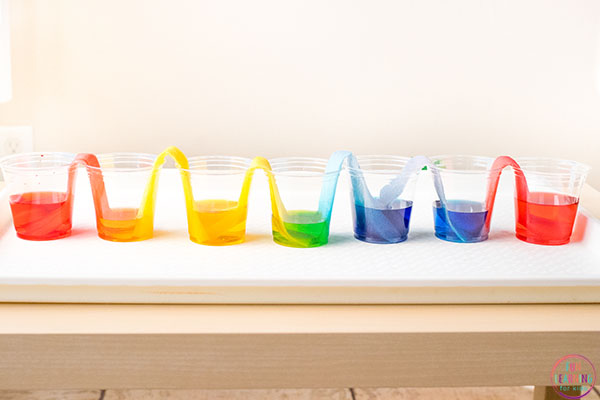
Doing the Walking Water Experiment
You want to try to use the same amount of food coloring in each cup. When I did this with my kids they did drop an extra one or two in since they can’t control it well, but I just added a drop or two more to the others to even it out.
6. Take a half sheet of paper towel and fold it in half lengthwise and in half again lengthwise.
7. Trim off some of the length so that there isn’t too much excess paper towel that will stick up in the air between each cup. This will make the water walk more quickly.
8. Place one half of a rolled paper towel in the 1st cup and place the other half in the cup next to it. Then another paper towel from 2nd cup and into the 3rd cup. This continues until you have placed the last paper towel that drapes over from the 6th cup to the 7th cup.
9. Stare at the cups and watch what starts happening. You should quickly be able to see the colored water begin to crawl up the paper towel.
10. Don’t forget to do the first part of the recording sheet. Students will predict what they think will happen.
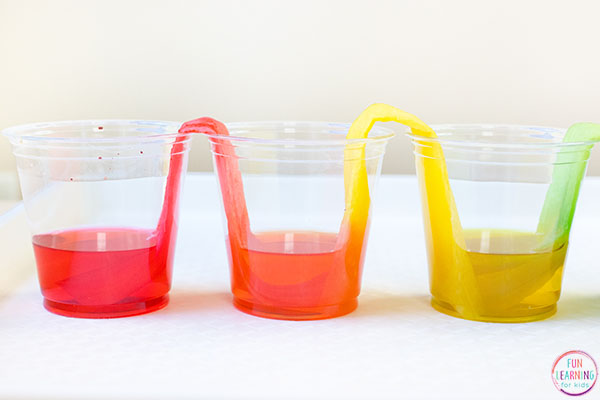
This walking water experiment is AWESOME!
Keep checking back every couple of minutes. Soon you will be able to see that the water has crawled all the way up the paper towel and is beginning to walk back down into the empty cup next to it.
Since the cup on either side of an empty cup has colored water in it, the two colors begin to mix in the empty cup. So cool!
Keep coming back throughout the two hours or soon and observe what is happening.
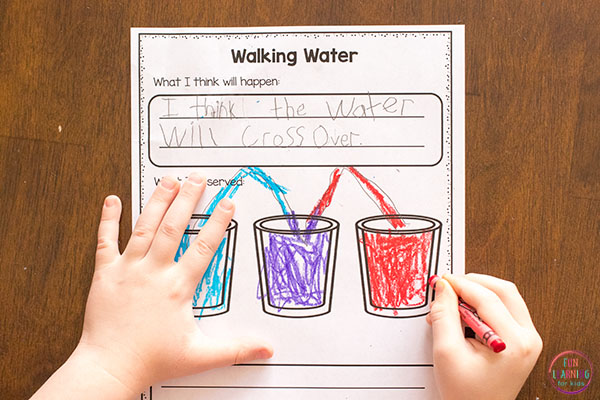
Question to Ask
What do you think will happen to the water?
What is happening now?
Why do you think the colors are changing?
Why might the water be able to move up against gravity like that?
How this Science Experiment Works
The water moves up the paper towels through a process called capillary action. The paper towel is made from fibers and the water is able to travel through the gaps in the fibers. The gaps in the paper towel act like capillary tubes and pull the water upward. This is what helps water climb from a plant’s roots to the leaves at the top of the plant or tree.
The water is able to move upward against gravity because of the attractive forces between the water and the fibers in the paper towel.
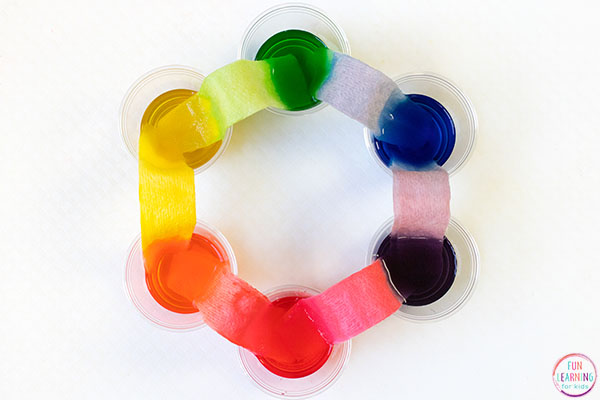
I even removed one of the red cups and made a color wheel so I could introduce the kids to that as well.
I hope your kids have a great time with this super cool walking water science experiment!

Other Cool Science Experiments for Kids
This rainbow Walking Water Science Experiment is one of our most popular science activities!
Try this super simple Oobleck recipe that only requires two household ingredients!
This rainbow skittles experiment is sure to WOW the kids!
You can also make a rainbow of flowers with this super cool color changing flowers experiment !
This pepper and soap experiment is very simple to do, but always engages the kids!
Did you know you can put paper under water and it will stay dry? Give it a try with this keep paper dry under water experiment . The kids love this cool trick!
Explore Newton’s color wheel while making colors disappear with this totally awesome science activity!
Explore chromatogography with this super fun STEAM activity that combines science and art!
This rain cloud jar science experiment give children a chance to explore clouds and rain in a hands-on and engaging way
The kids will get a kick out of this super cool dancing raisins science experiment !
Check out these other science experiments and activities for kids.
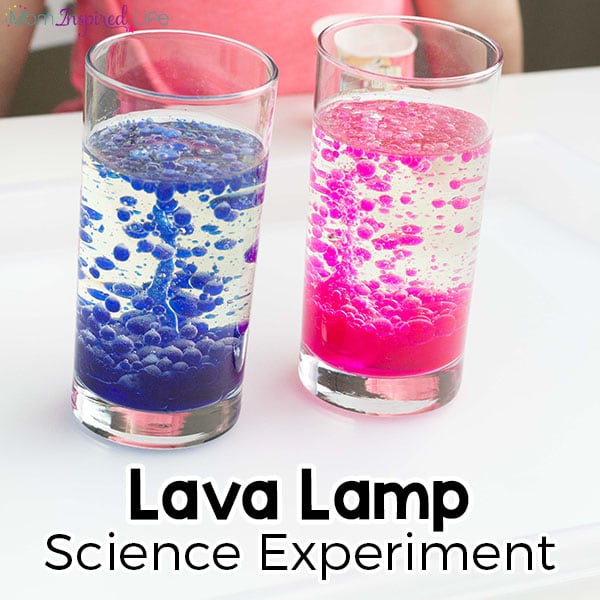
This lava lamp science experiment is always a hit with the kids!
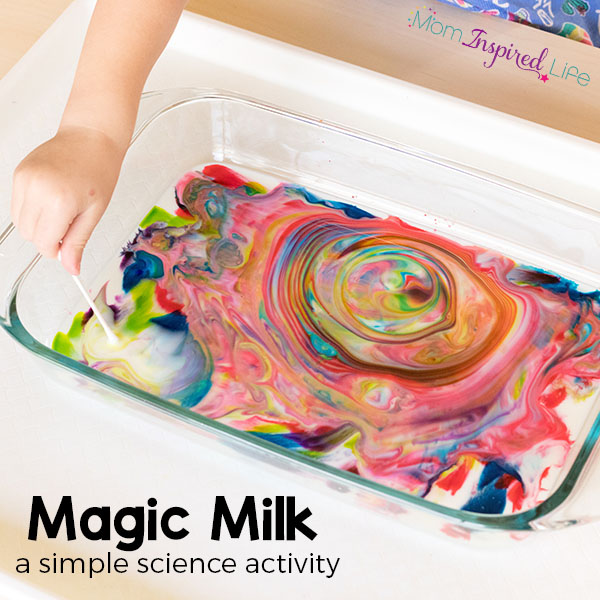
If you haven’t tried this magic milk science activity , you have to! It is so awesome and super easy to do.
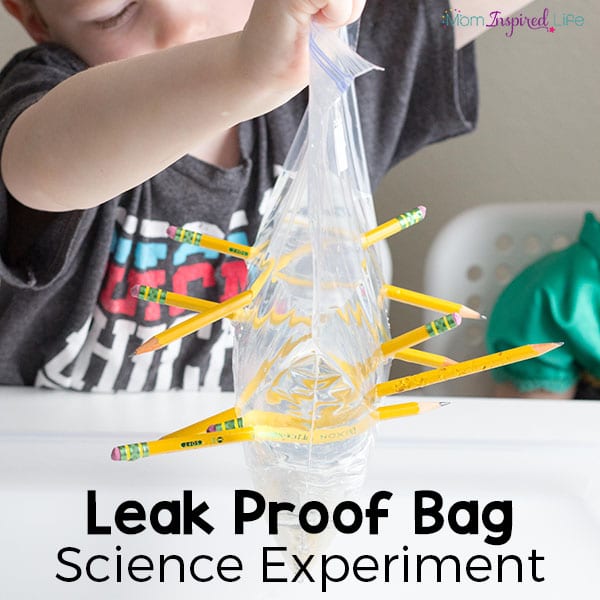
This leak proof bag science experiment will make your kids jaw drop! It’s hard to believe, but it works.
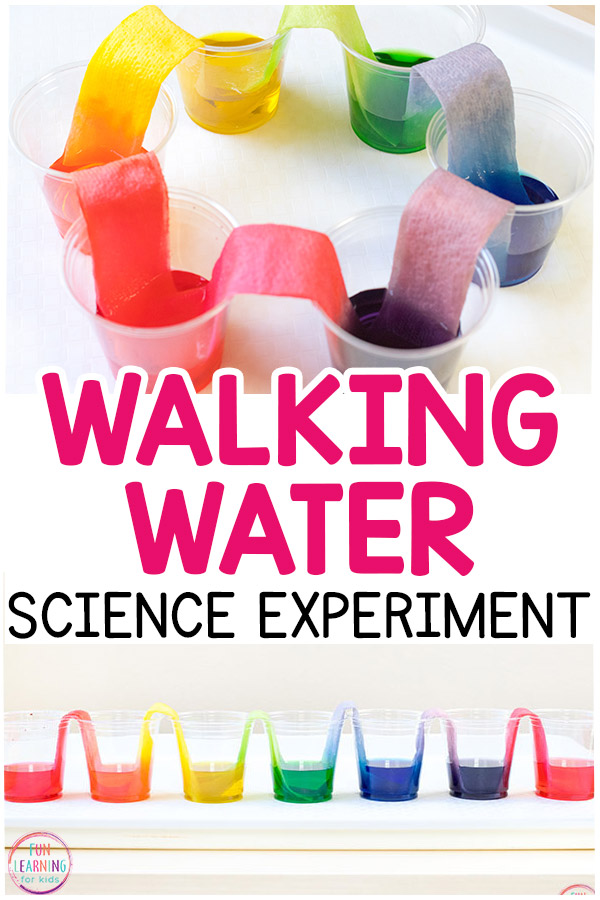

Walking Water Rainbow Science Experiment
Let’s make a walking water rainbow! There’s no better way for little scientists to learn about capillary action and color mixing than by making water walk (yes – walk!) in this colorful rainbow science experiment. This science experiment is a favorite of ours because it’s so easy to set up and the results are almost immediate.
Check out the simple step-by-step below and then gra b 30 more jaw-dropping (but easy prep!) science experiments kids will love from our shop!
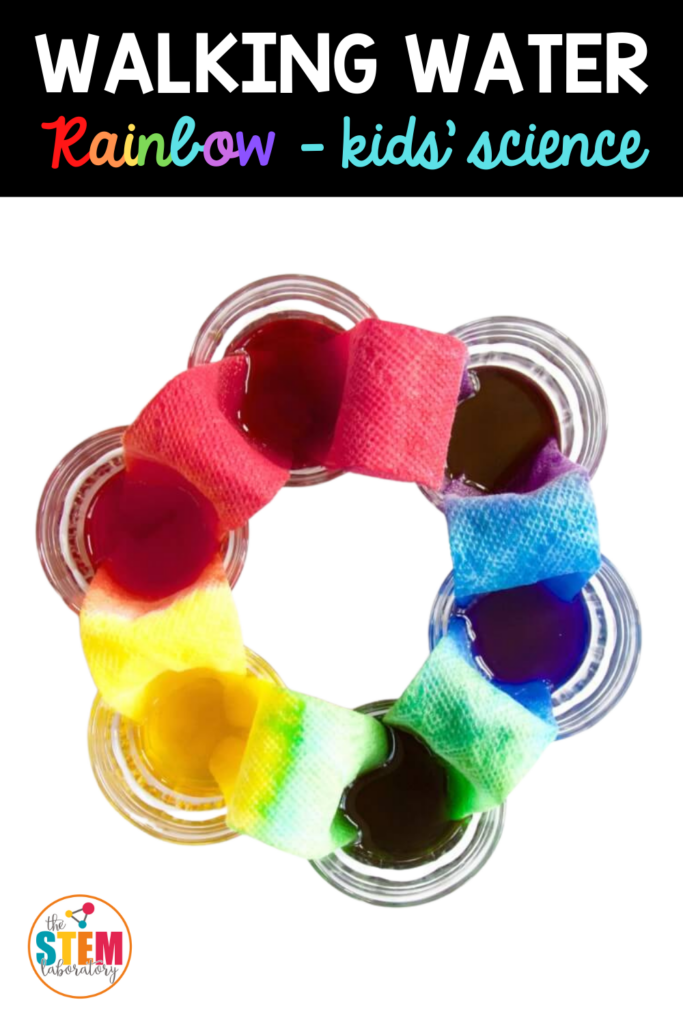
Getting Ready
To prep, I gathered our supplies:
- 6 wide-mouth glasses or jars
- Paper towels (use the kind where you can select a size)
- Food dye or liquid water colors (red, yellow, and blue)
I grabbed the six small glasses first . We’ve had success using wide-mouth drinking cups and canning jars, too. Even though they all worked, just remember that bigger glasses will need more food coloring.
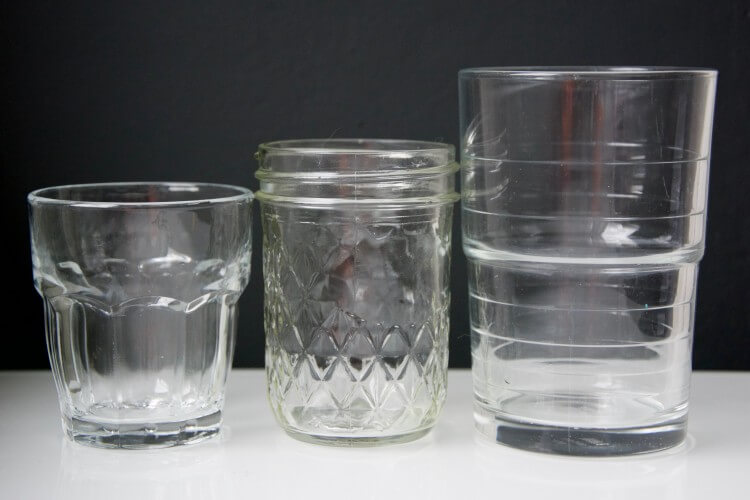
I ripped off six sheets of paper towel and folded each sheet in thirds, lengthwise.
We were using pretty small glasses, so I cut a few inches off the folded paper towel so it would fit in the glasses.
It’s a good idea to test your paper towel strip to make sure they fit properly in your glasses. They should be able to go from the bottom of one jar to the next without sticking up in the air too much. The paper towel on the left shows the just-right height. It’s important to set up this rainbow science experiment for success!
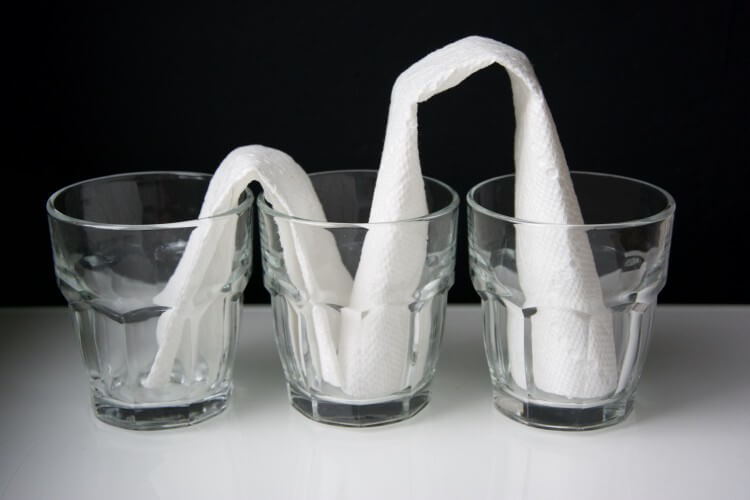
Making a Rainbow
This colorful rainbow science experiment is so simple and quick, it’s perfect for even the youngest little scientists. My 3 year old, Q, couldn’t wait to get started.
First, I had him line up the glasses and fill the first one with a good squirt of red watercolor , the third with yellow, and the fifth glass with blue. We left the other glasses empty.
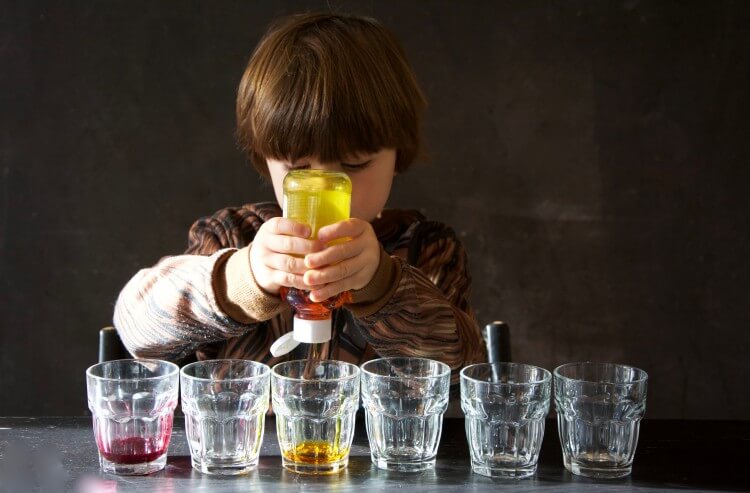
Next, I helped Q add water to the glasses with color until the colored water almost reached the top.
We moved the glasses into a circle and added the paper towels . Starting with the red, we added one end of the paper towel and then put the other end in the empty glass next to it.
We continued around until the last paper towel was placed into the red glass.
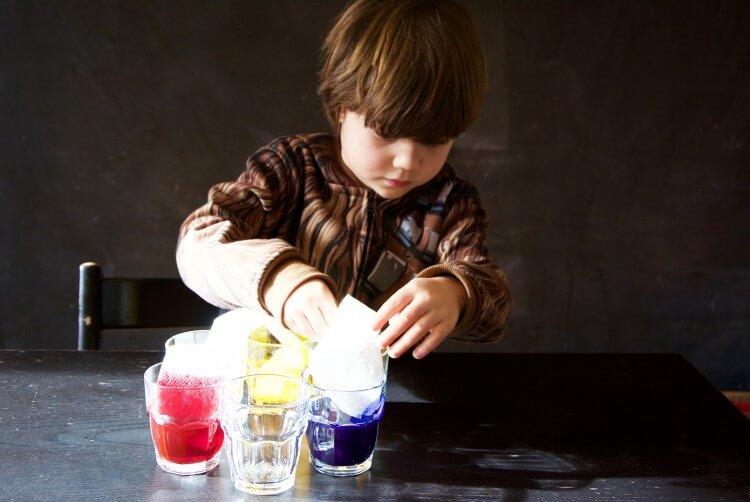
We saw the color wick up the paper towel right away. This rainbow science experiment doesn’t take long to get going!
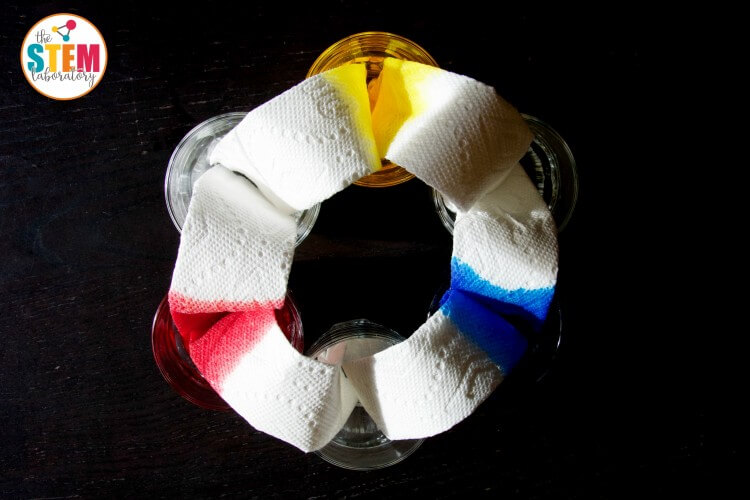
After another several minutes, the colored water had almost travelled the whole length of each paper towel.
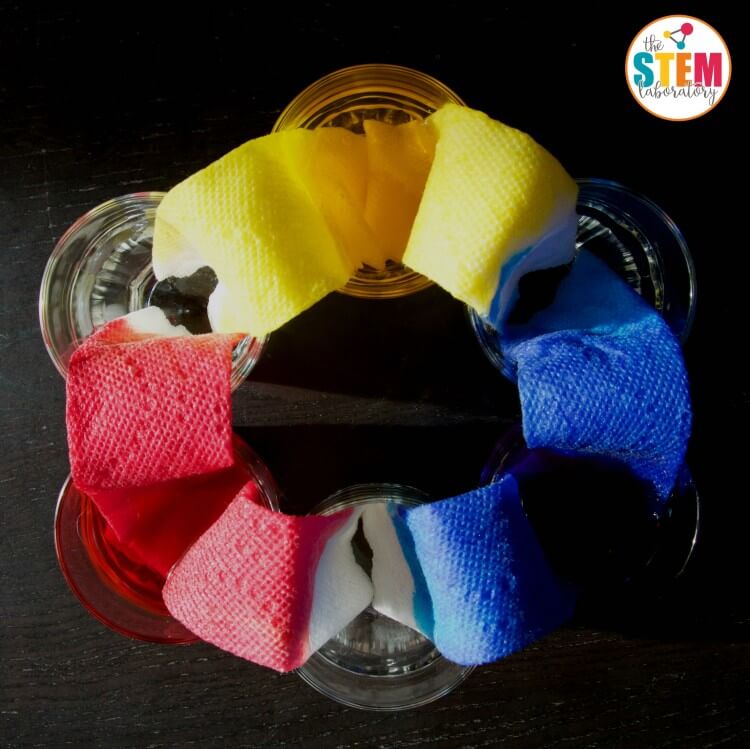
Five minutes later, the water had traveled all the way up and then down the paper towel and was dripping into the empty glass.
The yellow and red water dripped into the empty cup to make orange! It made for a good lesson on color mixing.
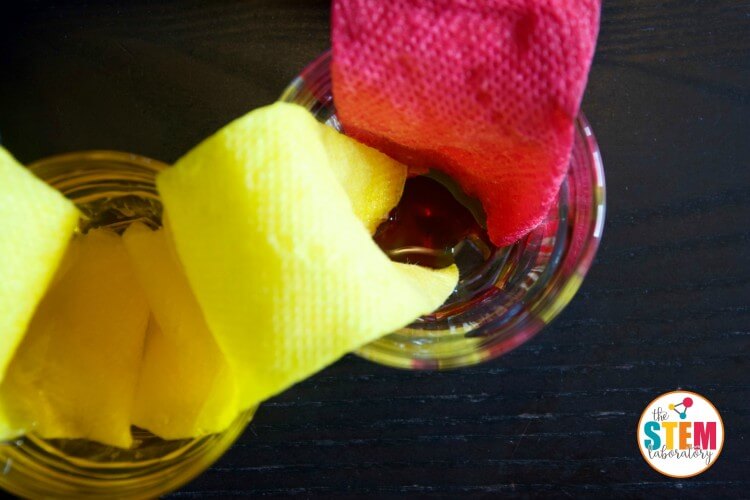
After another five minutes, we could see the water level had dropped in the red, yellow, and blue glasses and rose in the once empty glasses as the water continued to travel from the more full glasses to the less full glasses.
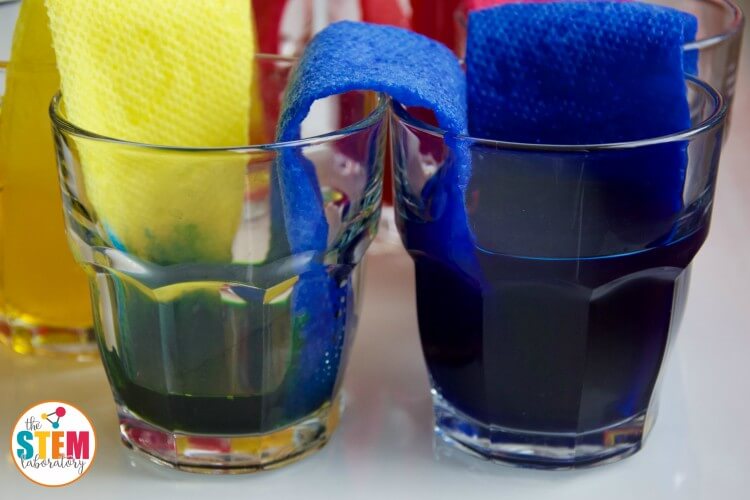
We grabbed a snack and watched our beautiful rainbow science experiment during the next 20 minutes. The water continued to walk from the primary colored glasses to fill the secondary-colored glasses until all the jars were filled equally.
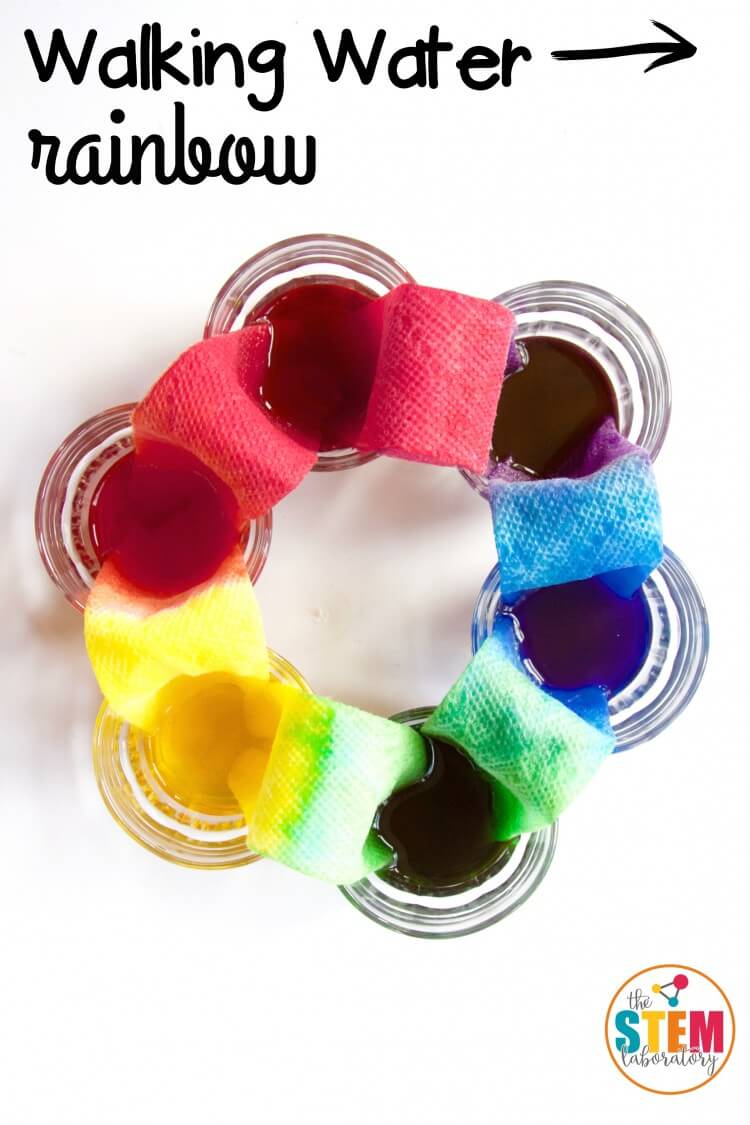
Not Working?
If you aren’t seeing much movement within a few minutes, it may be that you need to add more water to your colored water glasses. It really needs to be almost at the top for the water to walk quickly. So try topping off those glasses and seeing if that gets things moving.
If you see the water moving up the paper towel but it seems like it’s taking forever , it may be the type of paper towel you are using. You want a paper towel that will really hold a lot of water. We have used Bounty Select-a-Size and Target’s Up and Up Brand Select-a-Size with success.
It really is worth the extra effort of trying different cups and paper towels to get this activity to work. And once you have had success, don’t throw out those beautifully-colored paper towels or the colored water! We gently squeezed out our paper towels and let them dry in a heap on a baking sheet. We ended up with gorgeous tie-dyed looking paper towels to use for crafts and we used the leftover water as watercolors for painting with later.
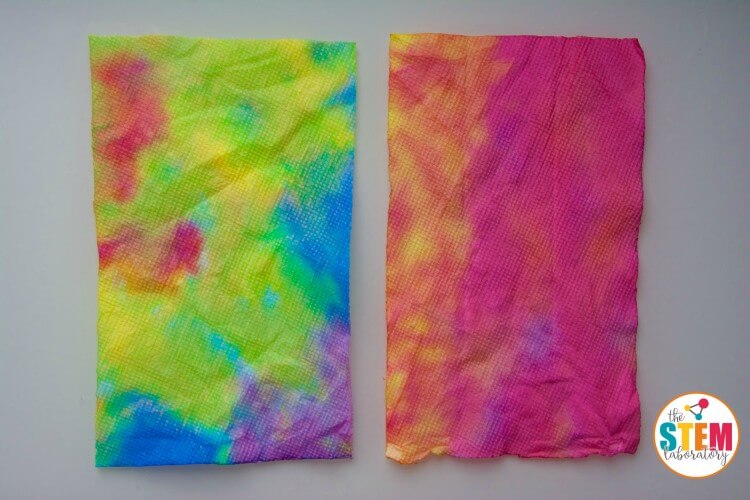
The Science Behind It
This rainbow science experiment is as magic as the science behind it. The colored water travels up the paper towel by a process called capillary action . Capillary action is the ability of a liquid to flow upward, against gravity, in narrow spaces. This is the same thing that helps water climb from a plant’s roots to the leaves in the tree tops.
Paper towels, and all paper products, are made from fibers found in plants called cellulose . In this demonstration, the water flowed upwards through the tiny gaps between the cellulose fibers. The gaps in the towel acted like capillary tubes, pulling the water upwards.
The water is able to defy gravity as it travels upward due to the attractive forces between the water and the cellulose fibers.
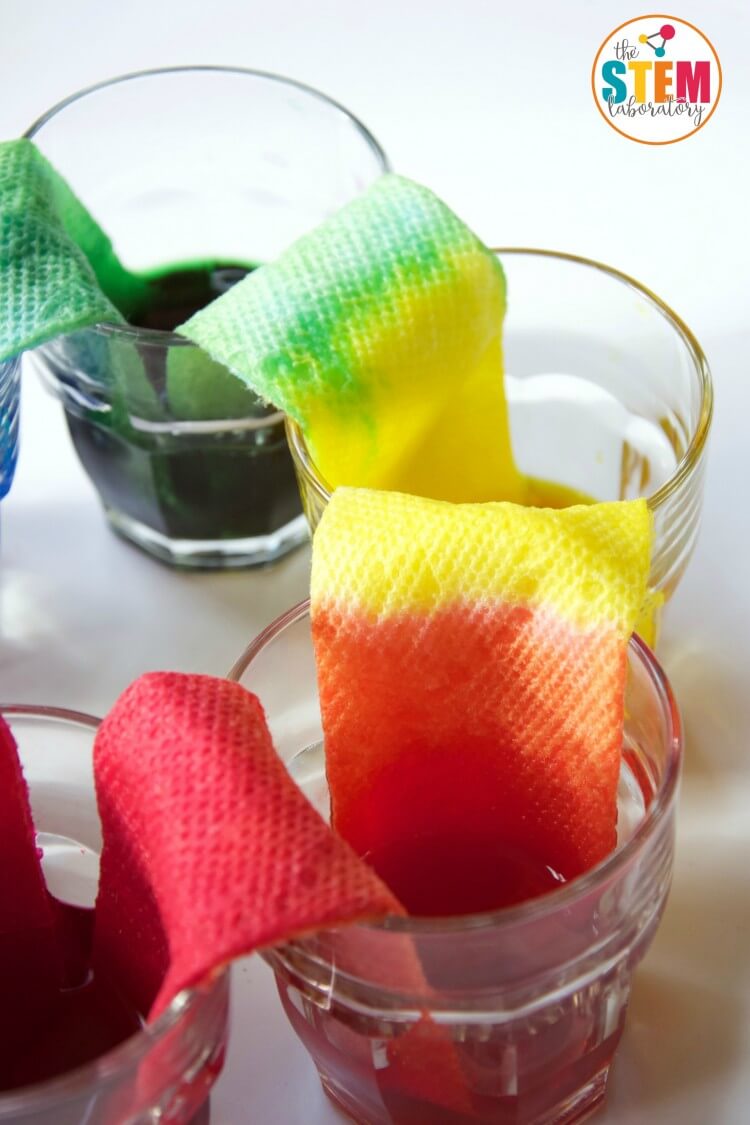
The water molecules tend to cling to the cellulose fibers in the paper towel. This is called adhesion .
The water molecules are also attracted to each other and stick close together, a process called cohesion . So, as the water slowly moves up the tiny gaps in the paper towel fibers, the cohesive forces help to draw more water upwards.
At some point, the adhesive forces between the water and cellulose and the cohesive forces between the water molecules will be overcome by the gravitational forces on the weight of the water in the paper towel.
When that happens, the water will not travel up the paper towel anymore. That is why it helps to shorten the length that colored water has to travel by making sure your paper towel isn’t too tall and making sure you fill your colored liquid to the top of the glass.
Rainbow Science Activity Extensions
Turn this demonstration into a true experiment by varying the water level (volume) you start with and seeing how long it takes the water to reach the empty glass.
Or start with the same volume of colored water and change the brand, type (single vs double ply, quilted vs not) or length of paper towel to see how long it takes for the water to “walk” to the empty glass.
You could even use the same volume of water, same length and brand of paper towel but vary the height of the filled glass , by raising them up on books, to see how that affects the speed of the water as it “walks” to the empty glass.
Have you had enough fun with the paper towels? Try using other paper products to see how the type of paper effects the results. Try toilet paper, printer paper, newspaper or a page from a glossy magazine. What do you predict will happen?
Grab a Record Sheet
Help kids keep track of their results by grabbing our free record sheet! Then grab 30 more jaw-dropping (but easy prep!) science experiments kids will love from our shop!
11 Comments
- Pingback: Ice Color Mixing - The Stem Laboratory
- Pingback: Color Matching Fish - Teach Me Mommy
- Pingback: EXPLODING PAINT ROCKETS STEAM ACTIVITY
- Pingback: FREE Rainbow Train Preschool Counting Game - Stay At Home Educator
- Pingback: Coloring Sheets - Playdough To Plato
- Pingback: Matching Colors and Numbers 1-6 | Liz's Early Learning Spot
- Pingback: Color Hunt Around the Room - Mrs. Jones' Creation Station
- Pingback: Colors Sorting Mats Game
- Pingback: Ultimate Boredom Buster: 101 Things To Do When Kids Are Bored
- Pingback: 15 Color Activities | Happy Days in First Grade
- Pingback: 5 Easy Science Experiments for Kids [With Video] – Baba Blast!
Leave a Reply Cancel reply
Your email address will not be published. Required fields are marked *
Cool Science Experiments Headquarters
Making Science Fun, Easy to Teach and Exciting to Learn!
Science Experiments
Color Changing Walking Water Science Experiment
Science or magic? This super quick, gravity defying experiment may surprise young scientists and work like magic, but don’t worry! The color changing walking water experiment is science through and through and fun for all ages.
Based on the very popular Walking Water Science Experiment using two glasses, you can observe the water walking AND changing color with only a few supplies you probably already have in your kitchen. This article includes a video to show you just how easy it is with detailed step-by-step instructions and the scientific explanations you need to understand how it works!
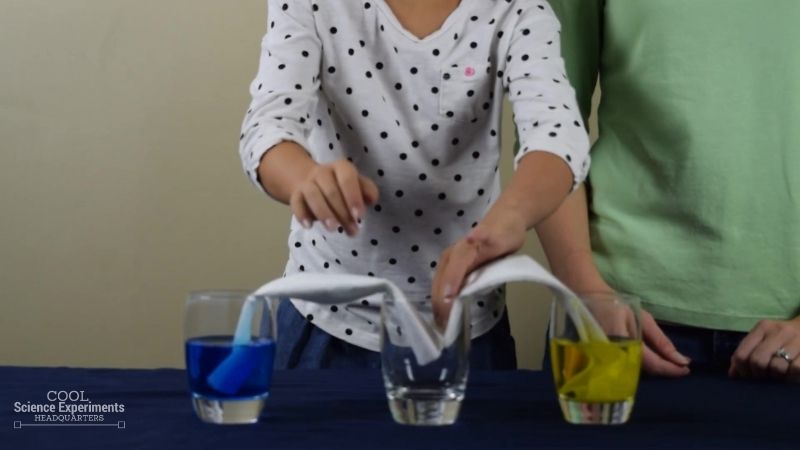
JUMP TO SECTION: Instructions | Video Tutorial | How it Works
Supplies Needed
- 3 Glasses of Equal Height
- Paper Towels
- Food Coloring (Blue & Yellow)
Color Changing Walking Water Science Lab Kit – Only $5
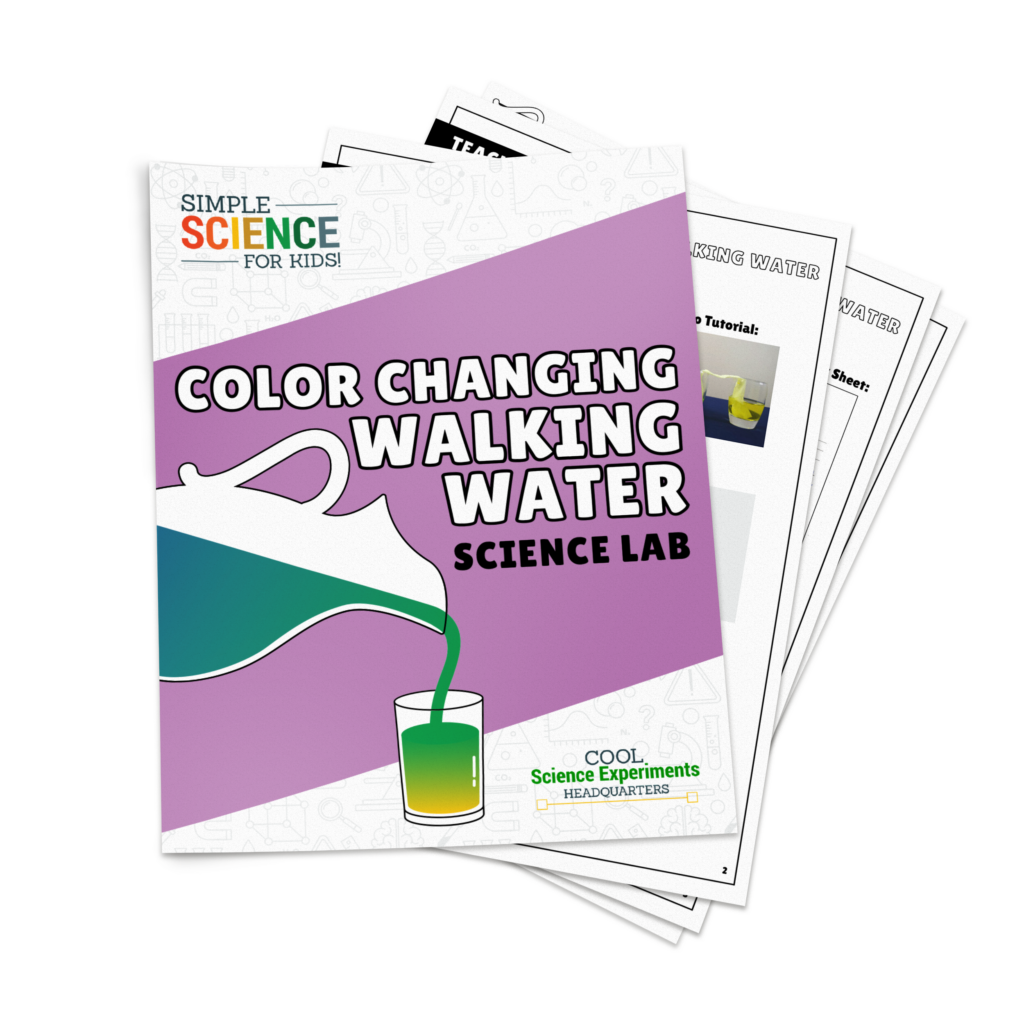
Use our easy Color Changing Walking Water Science Lab Kit to grab your students’ attention without the stress of planning!
It’s everything you need to make science easy for teachers and fun for students — using inexpensive materials you probably already have in your storage closet!
Color Changing Walking Water Science Experiment Instructions
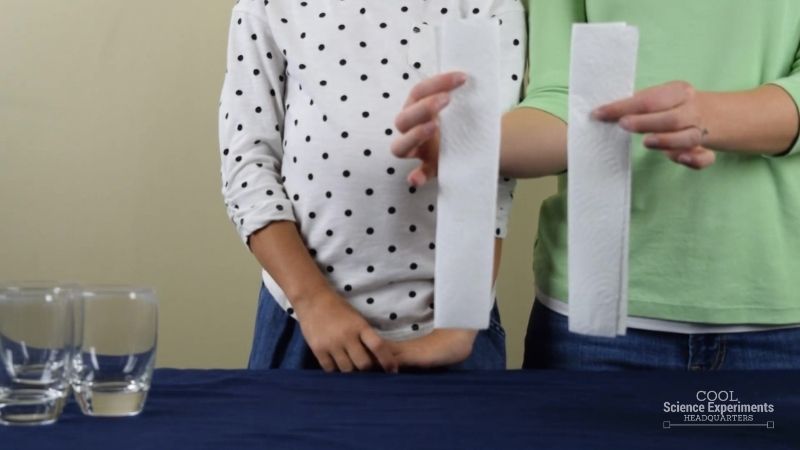
Step 1 – Prepare two strips of paper towel between 1 and 2 inches wide. Tip: We used one section of paper towel and folded it in half and then in half again until it was the correct width. Set the paper towel strips aside and gather the rest of the supplies
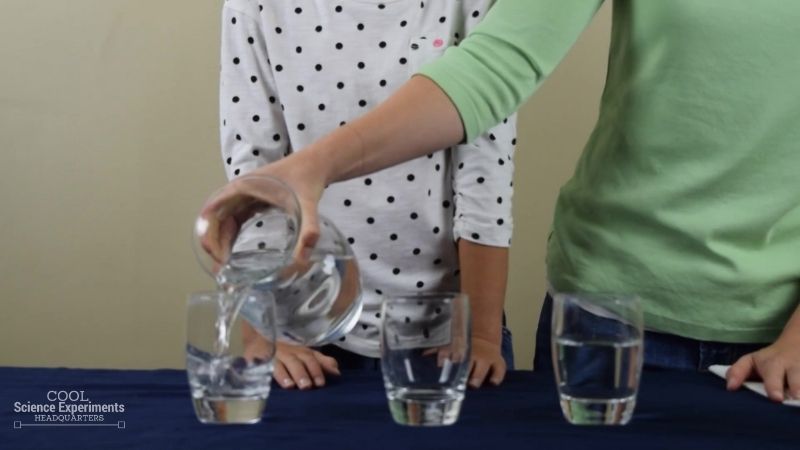
Step 2 – Next, Position your three empty glasses about 2-3 inches apart. Pour water into the two outside glasses until they are halfway full. Leave the middle glass empty.
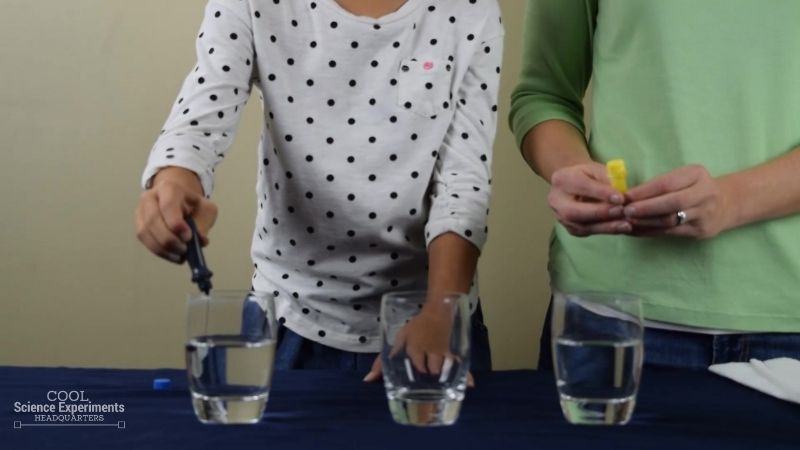
Step 3 – Add a few drops of food coloring to the water. Add blue food coloring to one glass and yellow food coloring to the other glass. Stir the water until the food coloring is fully combined.
Helpful Tip: If you don’t have blue & yellow food coloring, you can use red & yellow or red & blue.
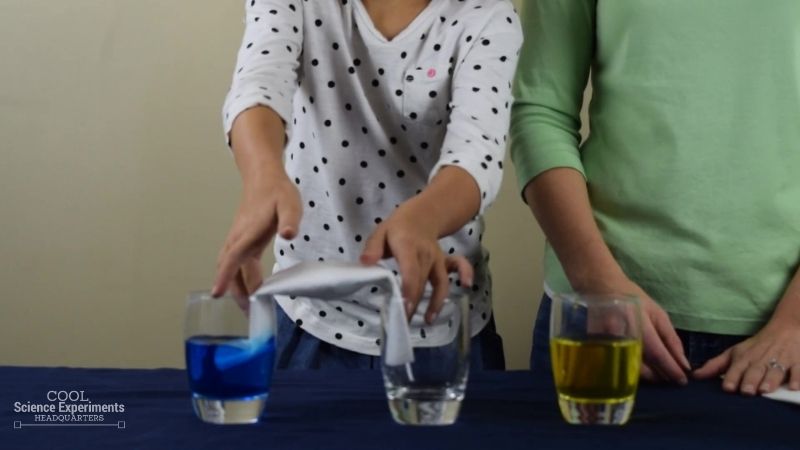
Step 4 – Take one of the strips of paper towel that you prepared in step 1. Place one end of the paper towel into the glass with the blue water. Then place the other end into the glass that is empty.
Step 5 – Take the other strip of paper towel that you prepared in step 1. Place one end of the paper towel into the glass with the yellow water. Then place the other end into the glass that is empty.
Take a moment to make some observations. What happened to the paper towel that was placed in the water? Do you think it is possible for the water in the first glass to move to the empty glass? What do you think will happen if the water moves to the middle glass? Write down your hypothesis (prediction) and then leave the glasses to sit and come back to check on them in about an hour.
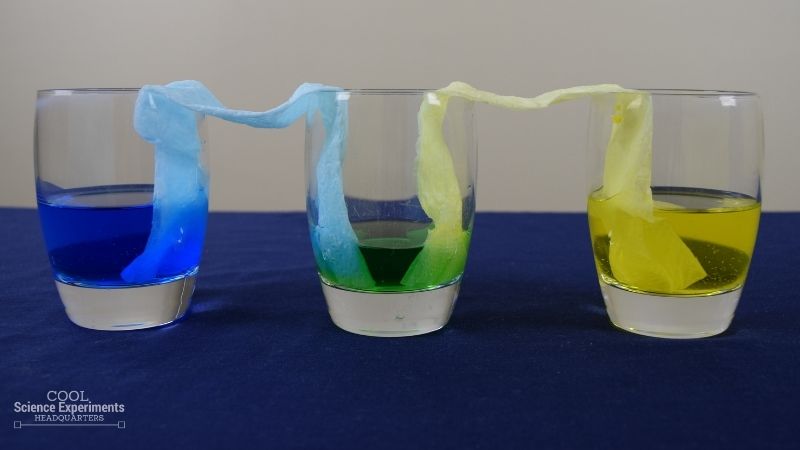
Step 6 – Return to the glasses and observe what has happened. What happened during the hour you were waiting? What do you think will happen if you wait a little longer. Do you think all the water in the outside glasses will move to the middle glass? Why or why not? Write down your hypothesis (prediction) and then leave the glasses to sit and come back to check on them in two hours.
Color Changing Walking water Science Experiment Video Tutorial
How Does the Experiment Work?
Why Does the Water Move Between Glasses? The water appears to defy gravity, but in reality, it moves because of a process called capillary action . Water is able to move against the force of gravity because water molecules stick to each other AND they stick to the fibers of the paper towel. As water molecules are attracted to the fibers of the paper towel, they pull other water molecules with them. The adhesive forces between the water and the fibers of the paper towel are stronger than the cohesive forces between the water molecules. This allows water to travel from one cup to another.
Capillary action is the combined force of attraction among water molecules and with the molecules of surrounding materials.
Why Does Water Change Color? Did you know that three basic colors can combine together to make any other color? These three basic colors are red, blue and yellow. They are referred to as primary colors. When two primary colors combine in equal amounts, they produce a secondary color. In this experiment, we chose blue and yellow (two primary colors) for the outside glasses. When the blue and yellow water mixed in the middle glass it turned green (a secondary color).
More Science Fun
Eventually, the water will stop moving over once both cups are filled with the same amount of water. Expand on the experiment, by estimating how long it will take for the water to move to the second jar. Then set a timer and find out how close your estimate was.
You can also try this experiment with other colors!
Red + Yellow = Orange Red + Blue = Purple
In addition, you can also try these other fun experiments that contain mixing colors:
- Coloring Changing Water Science Experiment – Science or magic? Try this experiment at home with your kids and watch their eyes light up as you pour the liquid into the bowl and “create” a new color.
- Discover How Colors are Made – This is a simple experiment that demonstrates how different colors are made.
I hope you enjoyed the experiment. Here are some printable instructions:
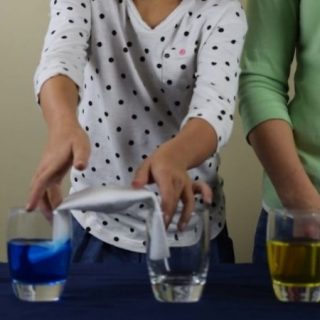
Instructions
- Prepare two strips of paper towel between 1 and 2 inches wide. Tip: We used one section of paper towel and folded it in half and then in half again until it was the correct width.
- Once you have your two paper towel strips ready, set them aside.
- Next, Position your three empty glasses about 2-3 inches apart.
- Pour water into the two outside glasses until they are halfway full. Leave the middle glass empty.
- Add a few drops of food coloring into the water. Stir the food coloring until the water is all one color. Tip: Use blue food coloring in one glass and yellow in the other.
- Take one of the strips of paper towel that you prepared in step 1. Place one end of the paper towel into the glass with the blue water. Then place the other end into the glass that is empty.
- Take the other strip of paper towel that you prepared in step 1. Place one end of the paper towel into the glass with the yellow water. Then place the other end into the glass that is empty.
- Observe the experiment right away. Do you notice that the water is “walking” up the paper towel? Now, leave the glasses alone and come back to check on them in an hour or two.
- Return to the glasses and observe what has happened.Tip: The longer you wait to check on the glasses, the more water will have moved to the middle glass. The water will stop moving over when all of the cups are filled with the same amount of water.
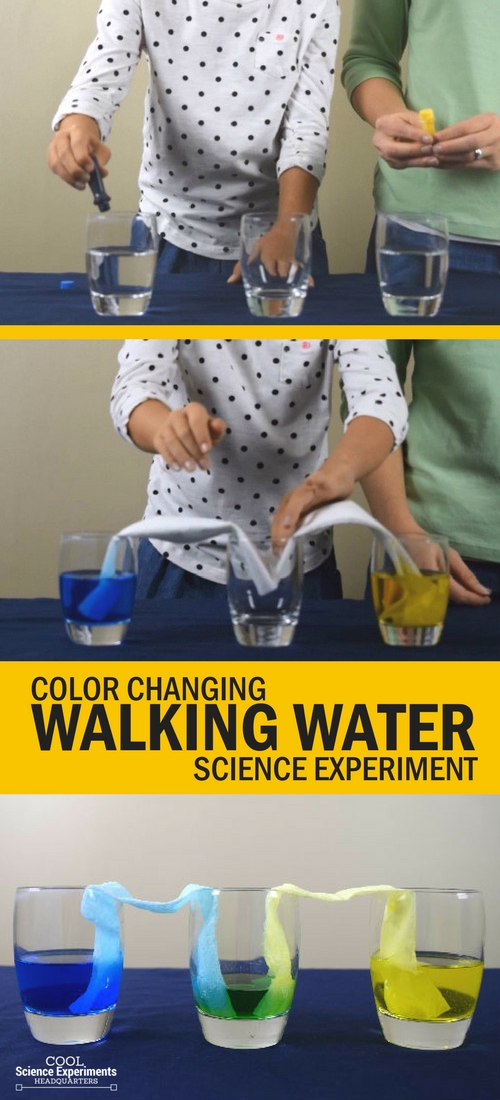
Reader Interactions
December 26, 2016 at 5:57 am
I want many science experiments for my kids.Thanks for your sharing.
December 10, 2019 at 7:33 pm
Thank you because I really needed something to do for my science fair and now i’m good to go
Leave a Reply Cancel reply
Your email address will not be published. Required fields are marked *
Save my name, email, and website in this browser for the next time I comment.

- Privacy Policy
- Disclosure Policy
Copyright © 2024 · Cool Science Experiments HQ
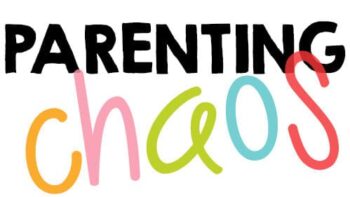
Crawling Colors! A FUN Science Experiment in Color Mixing
Sharing is caring!

Have you ever noticed how water seems to move through narrow spaces, like when you spill something on a paper towel and the liquid spreads out? That’s capillary action in action! It’s a pretty cool scientific concept, and one that’s easy to explore with this crawling colors science experiment!

Ready to grab your printable now? Click here for the Crawling Colors Science Experiment Packet.
In this experiment, we’re going to use food dye, water, and paper towels to observe how capillary action moves liquids from one cup to another. This is a great experiment for kids to learn about science in a hands-on way.
Walking Water Science Experiment for Kids
Plus, understanding how liquids move through narrow spaces is an important concept that can be applied to all sorts of things, from how plants absorb water to how ink moves through a pen. So let’s roll up our sleeves, grab some materials, and get ready to learn about capillary action!
Crawling Colors Science Experiment

- Primary Color Food Dye (Red, Yellow, Blue) or Washable Watercolors
- Paper Towels
- 5 Small Clear Containers
- 5 Large Clear Containers
Instructions
- Set up two sets of five cups in a line - one line for large cups and one line for small cups.
- For each glass use one sheet of paper towel folded into thirds. Test the paper towels to make sure that the paper towel can go all the way to the bottom of your cups without sticking too far out. The further the paper towel sticks upwards, the longer this experiment will take. After testing the towel length, set the paper towels aside.
- In the first, third, and fifth cup on each set add in food dye. Red for the first cup, yellow for the third cup, and blue for the fifth cup. Use a liberal amount of food dye.
- Fill the cups with food dye 3/4ths full with water. Leave the other two cups empty.
- Add the paper towels by placing one end into the cup with water and the other end into an empty cup. Follow the pattern of ROYGBIV.
- Set the timer.
- Watch the capillary action take place!
For more fun science experiments for kids visit ParentingChaos.com
Recommended Products
As an Amazon Associate and member of other affiliate programs, I earn from qualifying purchases.
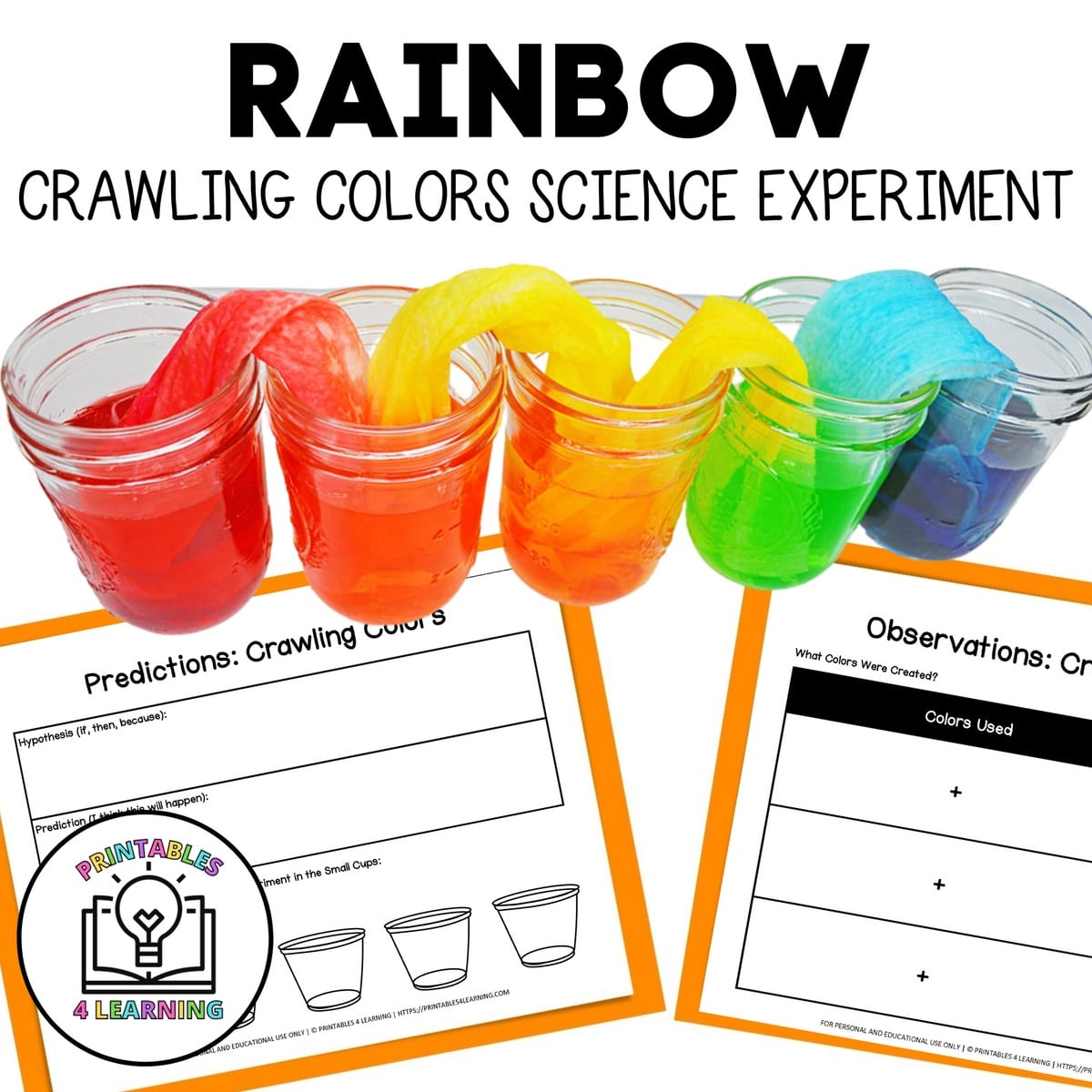
Did you make this project?
Please leave a comment on the blog or share a photo on Instagram
The Science Behind the Crawling Colors
Have you ever noticed how water seems to spread out on a paper towel? That’s because of something called capillary action. Capillary action is when a liquid can move through really small spaces, like the fibers in a paper towel, without needing any extra help. The liquid sticks to the material (adhesive forces) and also sticks to itself (cohesive forces), which creates a sort of chain reaction that moves the liquid through the tiny spaces. Capillary action is how liquids move through tiny spaces without any external force. It’s like a secret superpower of liquids!
In our experiment, we’re using paper towels as the porous material for capillary action to occur. When we dip one end of the paper towel into the cup of colored water, the water molecules are attracted to the fibers of the paper towel (adhesive forces) and stick to them. The water molecules are also attracted to each other (cohesive forces), so they pull each other along the paper towel.
This creates a chain reaction, with the water molecules in the paper towel pulling the water molecules in the cup along with them. As a result, the colored water crawls up the paper towel and into the empty cup, moving against the force of gravity.
To make the capillary action more visible, we’re added different colors of food dye to the cups. When the water crawls up the paper towel and into the empty cup, it takes the food dye with it, creating a colorful pattern. We used primary colors (red, yellow, and blue) to demonstrate how colors can blend together to create new colors, which is a great way to teach kids about color mixing, but you can do this experiment using any colors you desire!
The end result is a gorgeously vibrant rainbow that your kiddos will be proud to have created!
Variations of Walking Water to Try
The best part about science experiments is that you can always change things up and try new variations. Here are a few ideas to experiment with:
Experiment with Different Liquids
Capillary action isn’t just limited to water – you can try this experiment with other liquids too! Try using milk, vinegar, or even soda to see how capillary action works with different types of liquids.
Try Different Types of Paper Towels
Different paper towels have different absorbency rates, which can affect how quickly the colored water travels through the paper towel. Try using different brands or types of paper towels and see how the results compare. You could even try using other porous materials, like a coffee filter or a piece of fabric.
Vary the Water Level and/or Paper Towel Height
Another way to experiment with this activity is to change the height of the paper towel or the water level in the cups. You could also try adjusting both variables to see how it affects the movement of the colored water. This can help you learn more about how capillary action works under different conditions.
Crawling Colors Printable Packet
Our printable packet includes everything you need to conduct the crawling colors science experiment with ease. The packet includes clear directions, a predictions section, a color observations chart, a K-W-L chart, and a recording results section, making it easy for kids to track their progress and learn as they go.
Our 7-page packet is perfect for homeschooling, classroom activities, or just a fun weekend project with your family. With easy-to-follow instructions and a variety of helpful charts and tools, our packet takes the guesswork out of conducting the crawling colors experiment, and makes it easy for kids to understand the science behind capillary action.
So why wait? Order our printable packet today and get ready to watch your kids have fun while learning about the amazing world of science!
Please Share This Crawling Color Science Experiment
Your shares are how this site grows and I am sincerely grateful. Know a friend who’d like this? Please share it on Facebook or save it to your favorite board on Pinterest.

Leave a Comment Cancel reply
Save my name, email, and website in this browser for the next time I comment.

COMMENTS
To conduct the walking water science experiment, you will need the following materials: 7 clear cups or jars; Water; Food coloring (primary colors) ... you might start to see the water movement and colors mixing within a few minutes of setting up the experiment. However, complete water transfer from one cup to another may take anywhere from 30 ...
The Frozen Water Science Experiment is a fun and engaging project that teaches about the qualities of water and how it behaves when frozen. ... This experiment is often used in science classes to teach students about thermal conductivity and the physics of heat transfer. Similar Posts: 68 Best Chemistry Experiments: Learn About Chemical Reactions;
This walking water science experiment is so much fun and super easy to do! My kids absolutely loved it! It even comes with free printable recording sheets for kids as young as preschool! Check out the video to see how easy this walking water experiment really is. This rainbow activity is perfect for spring science!
Walking Water Science Experiment Step by Step Instructions. How Does the Experiment Work? The water appears to defy gravity, but in reality, it moves because of a process called capillary action.Water is able to move against the force of gravity because water molecules stick to each other AND they stick to the fibers of the paper towel.
Enjoy fun science experiments for kids that feature awesome hands-on projects and activities that help bring the exciting world of science to life. Escaping Water. Water can certainly move in mysterious ways, get the water from one cup to make its way up hill and back down into a second empty cup with the help of paper towels and an interesting ...
Let's make a walking water rainbow! There's no better way for little scientists to learn about capillary action and color mixing than by making water walk (yes - walk!) in this colorful rainbow science experiment. This science experiment is a favorite of ours because it's so easy to set up and the results are almost immediate. Check out ...
Note - if you would like to do the experiment in a circle instead of a straight line to save space, just make 1 red cup and place the cups in a circle (as shown in the first image). Kids will love watching the water travel and seeing the new colors being made in this easy science experiment! More Science Experiments for Kids
The color changing walking water experiment is science through and through and fun for all ages. Based on the very popular Walking Water Science Experiment using two glasses, you can observe the water walking AND changing color with only a few supplies you probably already have in your kitchen. This article includes a video to show you just how ...
Make water move between separate glasses with capillary action in this colorful activity. Jump to main content. ... Science Buddies is committed to creating content authored by scientists and educators. ... Use a paper towel to wipe off the spoon in between glasses, so you don't transfer the colors. Image Credit: Ben Finio, ...
This is a great experiment for kids to learn about science in a hands-on way. Walking Water Science Experiment for Kids Plus, understanding how liquids move through narrow spaces is an important concept that can be applied to all sorts of things, from how plants absorb water to how ink moves through a pen.